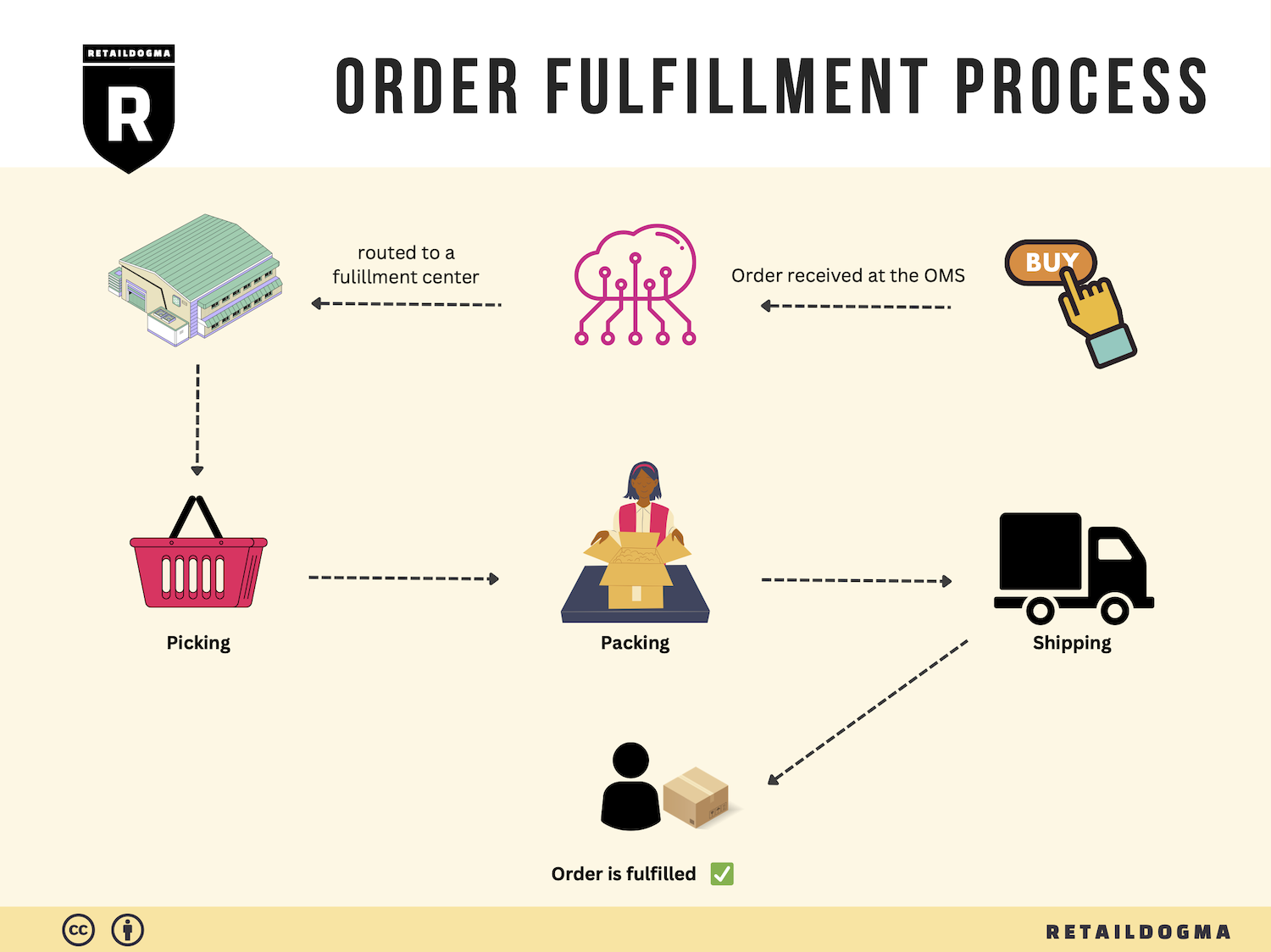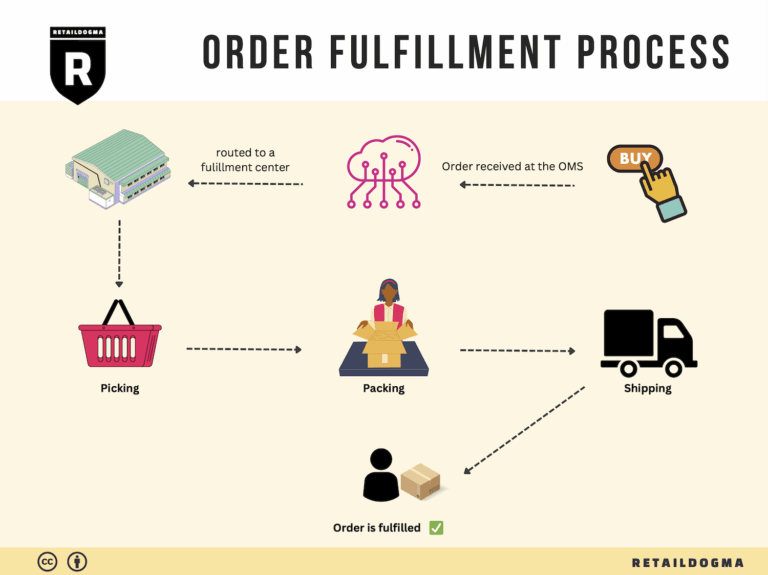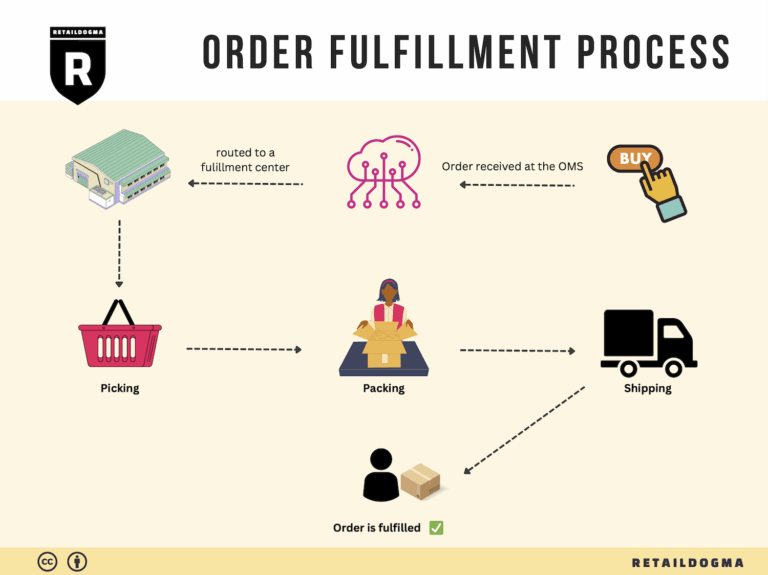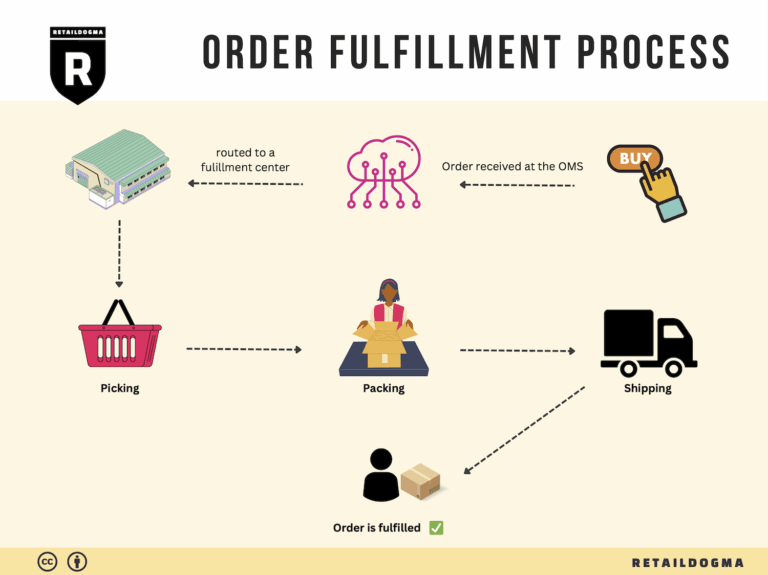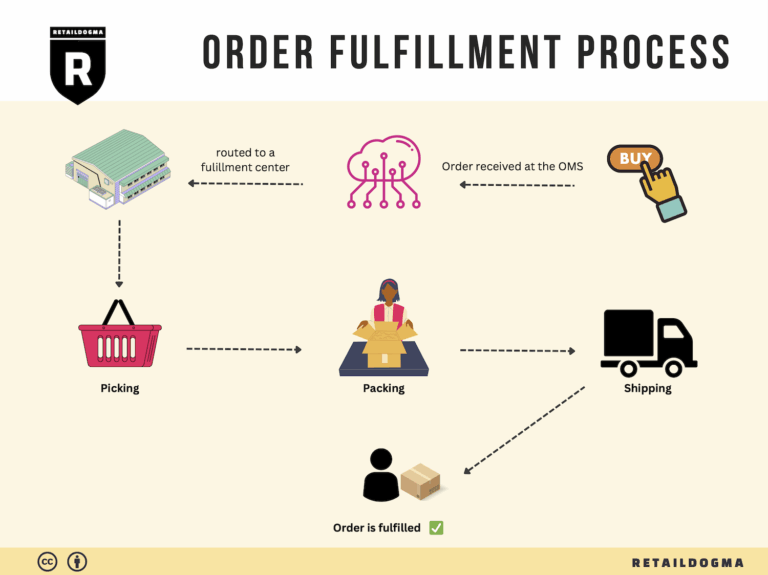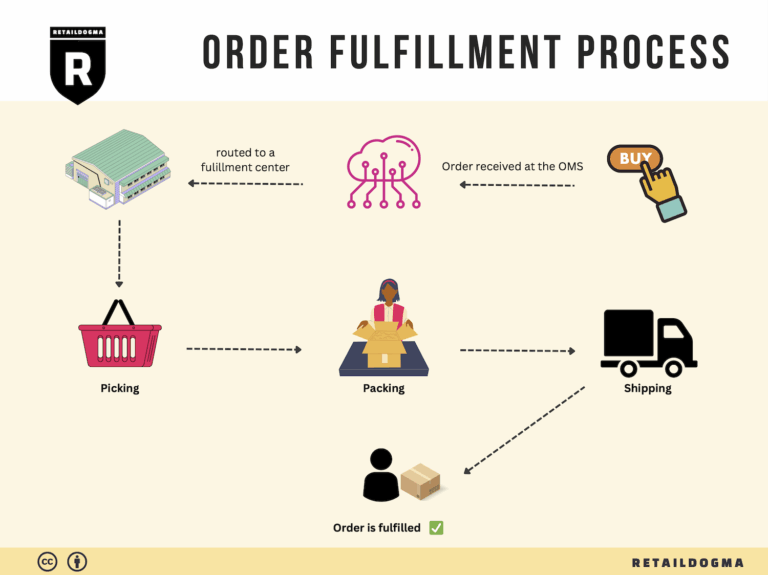How Order Fulfillment Works: A Step-by-Step Guide for Businesses
What is E-commerce Fulfillment? An Introduction for Growing Businesses
Understanding the E-commerce Fulfillment Landscape
For many growing online businesses, the excitement of scaling sales can quickly turn into a daunting challenge when it comes to fulfilling orders. The process of packing and shipping can become overwhelming, leading to delays, errors, and ultimately, dissatisfied customers. Fulfillment, in its simplest form, is the process of getting a product from your warehouse to your customer’s doorstep. It encompasses everything from inventory management to packaging, shipping, and handling returns.
As your business expands, so too does the complexity of your fulfillment needs. This guide aims to demystify e-commerce fulfillment, offering clarity on the various models available, such as Third-Party Logistics (3PL) and Fulfillment by Amazon (FBA). We’ll break down the core services that fulfillment providers typically offer, including pick-and-pack services, inventory management, and shipping logistics. Understanding these components is crucial for any entrepreneur looking to streamline their operations and enhance customer satisfaction.
Choosing the right fulfillment partner is a pivotal decision that can significantly impact your business’s efficiency and growth trajectory. This guide will provide insights on how to evaluate potential partners based on their capabilities, technology, and customer service. We’ll also discuss pricing structures, helping you navigate the often-complex landscape of fulfillment costs, so you can make informed decisions that align with your budget and growth goals.
By the end of this guide, our goal is to empower you with the knowledge needed to make smart logistics decisions that will support your business’s growth. Whether you’re just starting out or looking to optimize your existing fulfillment process, understanding the intricacies of e-commerce fulfillment will position you for success in a competitive marketplace. Let’s dive into the details and explore how effective fulfillment strategies can drive your business forward.
What You’ll Learn In This Guide
- What is E-commerce Fulfillment? An Introduction for Growing Businesses
- The Order Fulfillment Process: From ‘Buy’ Button to Customer’s Door
- Comparing Fulfillment Models: In-House vs. 3PL vs. Dropshipping
- A Deep Dive into Amazon FBA: Pros, Cons, and Who It’s For
- Core Services Offered by Fulfillment Centers
- How to Choose a Fulfillment Partner: A 6-Point Checklist
- Understanding Fulfillment Pricing: A Breakdown of Common Fees
- Frequently Asked Questions (FAQs) about Fulfillment
- Conclusion: Is Outsourcing Fulfillment the Right Move for Your Business?
- Important Disclaimer
The Order Fulfillment Process: From ‘Buy’ Button to Customer’s Door
1. Receiving Inventory
The order fulfillment process begins with receiving inventory from suppliers or manufacturers. This step involves the delivery of products to the warehouse, where they are unloaded and inspected for damage. Each item is typically assigned a Stock Keeping Unit (SKU), which serves as a unique identifier for tracking inventory.
Importance: Proper receiving processes ensure that the right products are in the right condition before they are stored. Any discrepancies or damages should be identified immediately to avoid complications later in the fulfillment cycle. Accurate receiving not only helps maintain inventory accuracy but also prevents financial losses due to damaged goods.
Key Term: SKU (Stock Keeping Unit) – A unique identifier for each product that helps in tracking and managing inventory.
2. Warehouse Storage
Once the inventory has been received and inspected, the next step is warehouse storage. Products are allocated specific locations within the warehouse based on their SKUs, which allows for efficient retrieval. This organization can be influenced by various factors, such as product size, demand, and turnover rate.
Importance: Effective warehouse storage minimizes the time spent locating items and reduces the risk of errors when picking orders. A well-organized warehouse layout also optimizes space and enhances overall operational efficiency. The goal is to ensure that products can be easily accessed when orders come in, facilitating a quicker response time.
Key Term: Warehouse Management System (WMS) – Software that assists in managing warehouse operations, including inventory tracking, order processing, and storage management.
3. Order Picking
Order picking is the process of retrieving products from their storage locations based on incoming customer orders. Warehouse staff use pick lists—documents that detail which items and quantities are needed for each order—to guide them through the picking process. Technology such as handheld scanners may also be employed to streamline this phase.
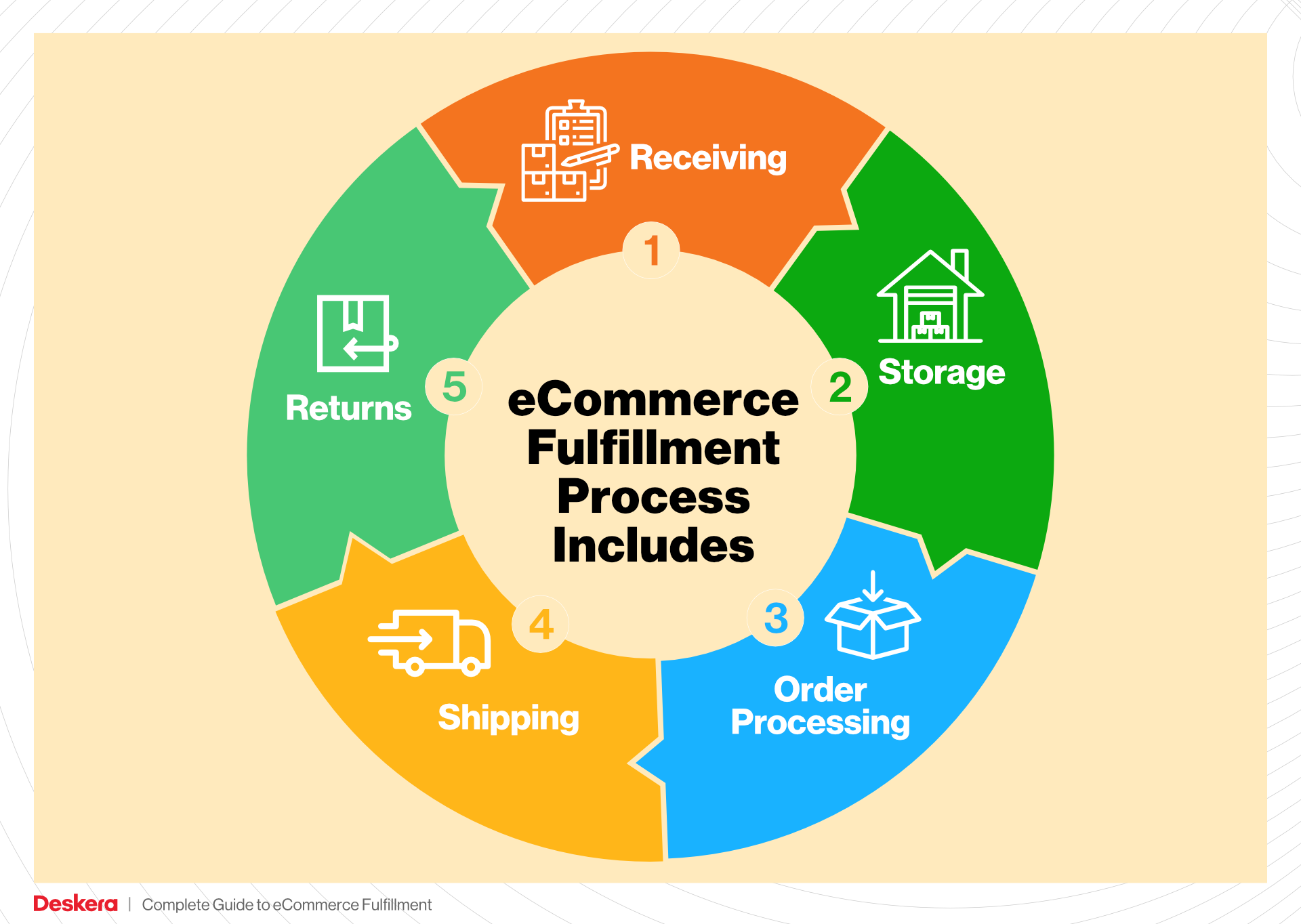
Importance: This step is critical because accurate picking directly impacts order fulfillment speed and accuracy. Errors in picking can lead to customer dissatisfaction, increased return rates, and additional costs. Efficient picking processes are essential for maintaining a positive customer experience and supporting business growth.
Key Term: Pick List – A document or digital tool that outlines the items to be picked for fulfilling customer orders, guiding the warehouse staff through the picking process.
4. Order Packing
After picking the items, the next step is order packing. This involves placing the picked items into appropriate packaging, ensuring they are secured for shipment. During this phase, the packing team may also perform quality checks to verify that the correct items are being sent and that they are in good condition. The choice of packaging is crucial, as it affects shipping costs and product safety.
Importance: Packing is vital for protecting products during transit and ensuring they arrive at the customer’s door in perfect condition. Effective packing also helps optimize shipping costs by selecting appropriately sized boxes and materials, which can significantly reduce overall logistics expenses.
Key Term: Packaging Optimization – The process of selecting the right materials and box sizes to minimize shipping costs while ensuring product safety during transit.
5. Shipping & Delivery
The final step in the order fulfillment process is shipping and delivery. Once the orders are packed, they are handed over to shipping carriers for delivery to the customer. This process involves generating shipping labels, tracking numbers, and coordinating with carriers to ensure timely dispatch.
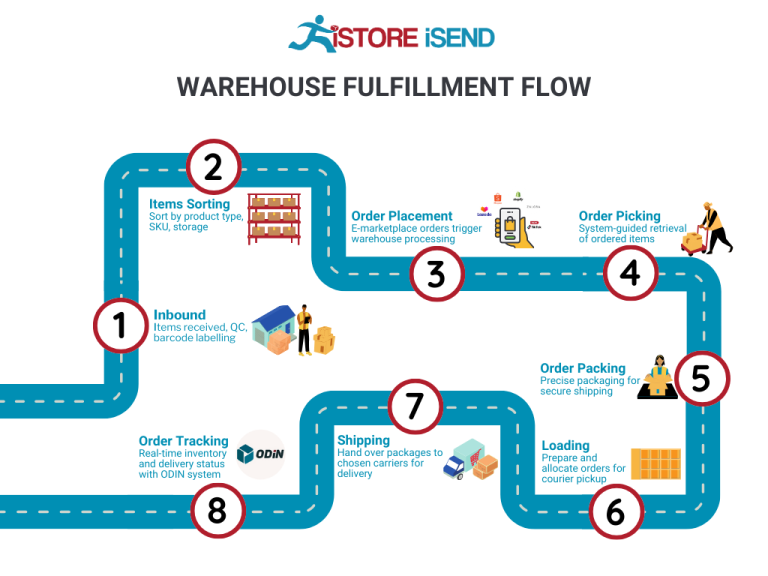
Importance: Timely shipping is crucial for customer satisfaction, as delays can lead to frustration and loss of trust in the brand. Efficient management of shipping processes, including choosing the right carriers and shipping methods, can significantly impact operational costs and delivery speed.
Key Term: Shipping Carrier – A company responsible for transporting goods from the fulfillment center to the customer, such as UPS, FedEx, or DHL.
By understanding and effectively managing each of these five steps—Receiving Inventory, Warehouse Storage, Order Picking, Order Packing, and Shipping & Delivery—e-commerce businesses can optimize their fulfillment processes, enhance customer satisfaction, and scale their operations successfully.
Comparing Fulfillment Models: In-House vs. 3PL vs. Dropshipping
Fulfillment Models Comparison
| Model | Who Handles Inventory | Best For (Business Stage) | Key Advantage | Key Disadvantage |
|---|---|---|---|---|
| In-House Fulfillment | The e-commerce business itself | Startups or established businesses | Full control over inventory and operations | High overhead costs and resource-intensive |
| Third-Party Logistics (3PL) | A specialized logistics provider | Growing businesses and scale-ups | Expertise and scalability without heavy investment | Less control over inventory and processes |
| Dropshipping | Suppliers or manufacturers | New entrants and low-capital startups | Low upfront costs and minimal risk | Lower profit margins and dependency on suppliers |
In-House Fulfillment
In-house fulfillment refers to the process where e-commerce businesses manage their own inventory, warehousing, and shipping operations. This model is particularly beneficial for startups or established businesses that require complete control over their inventory and fulfillment processes. By handling everything internally, businesses can ensure quality control, customize packaging, and provide tailored customer service. However, this model comes with significant overhead costs, including warehousing, staffing, and technology investments, which can be a strain on resources. In-house fulfillment can be labor-intensive and may require a robust infrastructure to efficiently manage order processing, especially during peak seasons. As businesses scale, maintaining an in-house operation may become increasingly challenging, requiring a strategic reevaluation of their fulfillment strategy.
Third-Party Logistics (3PL)
Third-party logistics (3PL) involves outsourcing fulfillment operations to specialized providers who handle inventory management, warehousing, order processing, and shipping. This model is ideal for growing businesses and scale-ups that need to optimize their logistics without the heavy investment in infrastructure. 3PL providers bring expertise, technology, and scalability to the table, allowing businesses to focus on core operations like marketing and product development. They can also provide value-added services such as kitting, custom packaging, and real-time inventory management. However, one of the key disadvantages is the reduced control over inventory and fulfillment processes, which can lead to discrepancies or delays if not managed properly. Businesses must carefully choose a 3PL partner that aligns with their operational needs and customer service expectations to mitigate risks.
Dropshipping
Dropshipping is a fulfillment model where businesses sell products without holding any inventory themselves. Instead, they partner with suppliers or manufacturers who handle the storage, packaging, and shipping directly to customers. This model is particularly attractive for new entrants and low-capital startups, as it requires minimal upfront investment and allows for a wide range of products without the financial burden of inventory management. The low-risk nature of dropshipping means that businesses can experiment with various products and markets without significant financial exposure. However, dropshipping often comes with lower profit margins due to the reliance on suppliers, and businesses may face challenges related to order fulfillment speed and quality control. Additionally, dependency on suppliers can lead to issues with stock availability and shipping delays, which can affect customer satisfaction and brand reputation. Businesses considering dropshipping must weigh these risks against the flexibility and low overhead costs that this model offers.
A Deep Dive into Amazon FBA: Pros, Cons, and Who It’s For
Understanding Fulfillment by Amazon (FBA)
Fulfillment by Amazon (FBA) is a service provided by Amazon that allows sellers to store their products in Amazon’s fulfillment centers. Amazon then takes care of storage, packaging, and shipping of these products directly to customers. This service also includes customer service and returns handling, making it a comprehensive solution for e-commerce sellers looking to leverage Amazon’s vast logistics network.
How FBA Works
-
Product Listing: Sellers create product listings on Amazon, just like they would for any other product.
-
Inventory Shipment: Sellers ship their products to Amazon’s fulfillment centers. They must prepare and package their products according to Amazon’s guidelines to ensure compliance.
-
Storage: Amazon stores the inventory in their warehouses until an order is placed.
-
Order Fulfillment: When a customer places an order for a seller’s product, Amazon picks, packs, and ships the item on behalf of the seller.
-
Customer Service: Amazon handles all customer inquiries and returns related to FBA products, providing a seamless experience for both sellers and buyers.
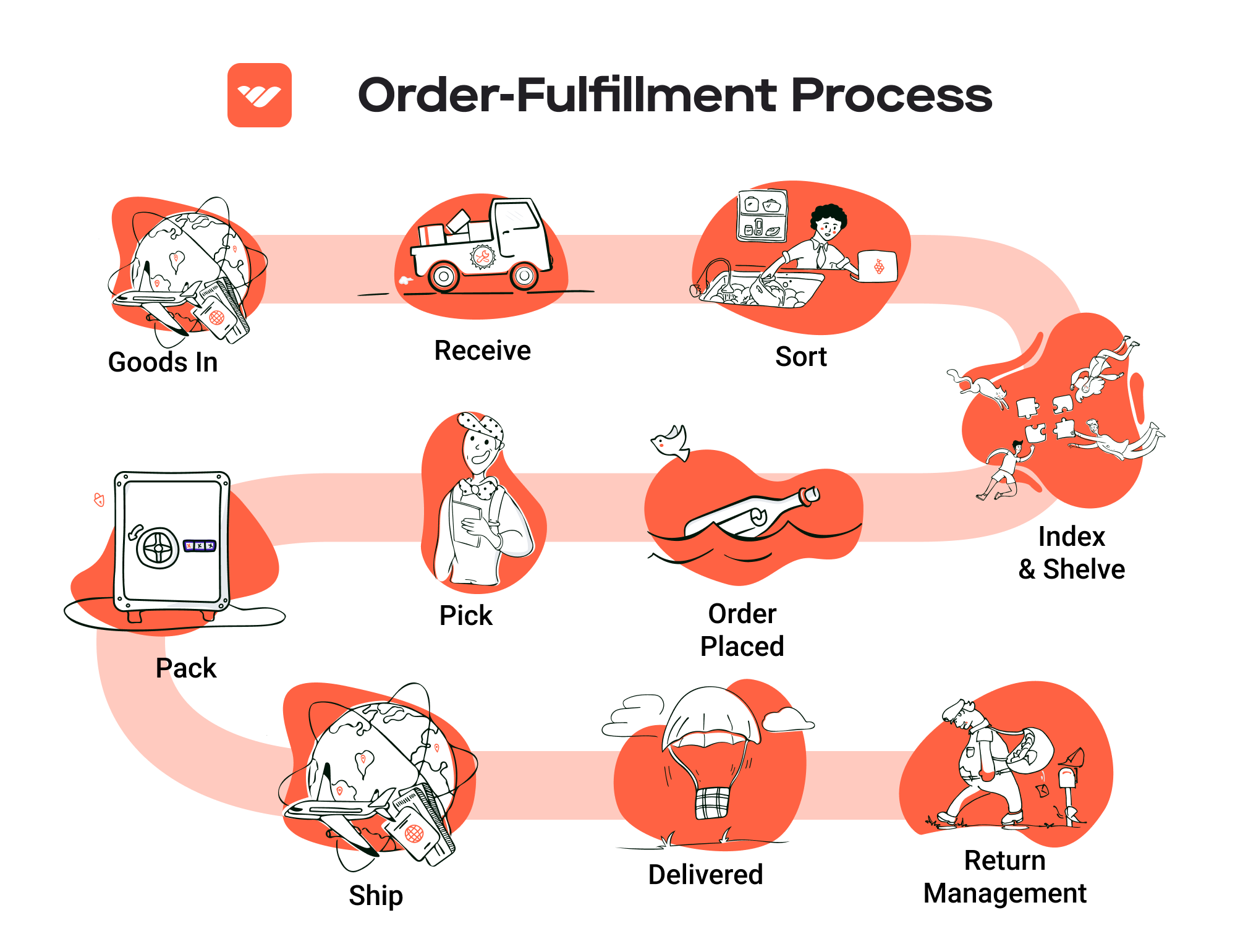
-
Payments: Sellers receive payment for sales, minus Amazon’s fees, typically every two weeks.
Pros of FBA
-
Prime Eligibility: Products fulfilled by Amazon are eligible for Amazon Prime, which can significantly increase visibility and sales. Prime members often prefer products with Prime shipping due to the quick delivery times.
-
Customer Trust: Leveraging Amazon’s trusted brand can enhance customer confidence in purchasing products. Buyers are more likely to choose FBA products because of Amazon’s reliable customer service and return policies.
-
Multi-Channel Fulfillment: FBA allows sellers to fulfill orders from other sales channels (e.g., their own website) using Amazon’s infrastructure. This provides flexibility and scalability for growing businesses.
-
Scalability: FBA can easily scale with a business. As sales grow, sellers can send more inventory to Amazon without needing to invest in their own warehousing and logistics.
-
Time Savings: By outsourcing fulfillment to Amazon, sellers can focus on other critical aspects of their business, such as marketing and product development, rather than logistics.
-
Advanced Logistics: Amazon’s sophisticated logistics network ensures fast shipping, which can enhance customer satisfaction and lead to repeat purchases.
Cons of FBA
-
High Fees: While FBA can simplify logistics, it comes at a cost. Sellers incur various fees, including storage fees and fulfillment fees. These can add up, particularly for low-margin products.
-
Strict Inventory Rules: Amazon has strict guidelines for inventory management, including minimum performance metrics that sellers must meet. Failure to comply can lead to penalties or account suspension.
-
Commingling Risks: FBA products may be commingled with inventory from other sellers, leading to potential issues with counterfeit or damaged goods. This can impact seller reputation and customer satisfaction.
-
Limited Control: Sellers have less control over the fulfillment process compared to managing their own warehouses. Issues such as stockouts or shipping errors may occur without direct oversight.
-
Long-Term Storage Fees: If inventory doesn’t sell quickly, sellers may face long-term storage fees, further eating into their profits.
-
Return Management: While Amazon handles returns, the process can sometimes be less favorable for sellers, particularly if customers abuse the return policy.
Who is FBA Best For?
Fulfillment by Amazon is particularly beneficial for:
-
New Sellers: Those new to e-commerce can take advantage of Amazon’s established infrastructure and customer base without the need for significant upfront investment in logistics.
-
High-Volume Sellers: Businesses that can move a high volume of products can benefit from the economies of scale that FBA offers, making it easier to manage logistics efficiently.
-
Sellers with Low-Margin Products: For sellers with low-margin products, the convenience of FBA can outweigh the fees, especially if it leads to increased sales through Prime eligibility and customer trust.
-
Brands Seeking Exposure: Sellers looking to gain visibility in the crowded Amazon marketplace can leverage FBA to enhance their product offerings and improve customer experience.
-
Multi-Channel Sellers: Businesses that sell across various platforms can streamline their operations using FBA for fulfillment, allowing for consistent inventory management and shipping processes.
In summary, Fulfillment by Amazon offers a robust solution for e-commerce sellers, combining the benefits of Amazon’s logistics capabilities with the potential for increased sales through Prime eligibility and customer trust. However, businesses must carefully weigh the costs and constraints associated with FBA to determine if it aligns with their operational goals and product strategies.
Core Services Offered by Fulfillment Centers
Inventory Management & Warehousing
Inventory management and warehousing are foundational services provided by fulfillment centers that ensure your products are stored efficiently and tracked accurately. Fulfillment centers utilize advanced inventory management systems that allow for real-time tracking of stock levels, facilitating better decision-making regarding order fulfillment and restocking.
The benefits of effective inventory management include reduced carrying costs and minimized stockouts or overstock situations. With a reliable fulfillment partner, e-commerce businesses can maintain optimal inventory levels, ensuring that popular products are always available while reducing the risk of excess inventory that ties up capital. Additionally, accurate inventory tracking minimizes the chances of order errors, enhancing customer satisfaction through timely and correct deliveries.
Pick and Pack Services
Pick and pack services are integral to the order fulfillment process, involving the selection (picking) of products from inventory and packaging (packing) them for shipment. Fulfillment centers employ sophisticated systems and technology to streamline this process, allowing for quick and efficient order handling.
The primary benefit of pick and pack services is the speed and accuracy they bring to order fulfillment. Automated systems can optimize the picking routes, significantly reducing the time taken to gather items for an order. This efficiency is crucial for e-commerce businesses, especially those experiencing high volumes of orders, as it helps to improve turnaround times and enhances the overall customer experience. Furthermore, by utilizing standardized packing methods, fulfillment centers can reduce shipping costs and minimize damage during transit, further adding value to the service.
Kitting and Assembly
Kitting and assembly involve grouping multiple products together into a single package or creating custom kits tailored to specific customer needs. This can range from simple bundling of products to complex assembly tasks, depending on the requirements of the e-commerce business.
The advantage of kitting and assembly services lies in their ability to create unique product offerings and streamline the fulfillment process. For instance, businesses can offer promotional bundles or subscription boxes that cater to customer preferences. This not only enhances the customer experience but also increases average order value. Additionally, by outsourcing kitting and assembly to a fulfillment center, e-commerce businesses can save on labor costs and focus their resources on core activities such as marketing and product development.
Returns Management (Reverse Logistics)
Returns management, or reverse logistics, refers to the process of handling returned products efficiently. This includes receiving, inspecting, restocking, and managing the return of items from customers back to inventory. Fulfillment centers provide systems and processes that facilitate smooth returns, including clear return policies and streamlined processing.
The benefits of effective returns management are manifold. First, it helps maintain customer satisfaction by making the return process hassle-free, which is crucial in the competitive e-commerce landscape. A well-managed returns process can also provide valuable insights into customer preferences and product performance, allowing businesses to make data-driven decisions for future product offerings. Moreover, by efficiently restocking returned items, fulfillment centers can minimize losses and recover potential revenue, ultimately enhancing the overall profitability of the e-commerce operation.
In summary, partnering with a fulfillment center for these core services allows e-commerce businesses to scale effectively. By leveraging inventory management, pick and pack services, kitting and assembly, and returns management, businesses can improve operational efficiency, enhance customer satisfaction, and focus on strategic growth initiatives.
How to Choose a Fulfillment Partner: A 6-Point Checklist
Location & Warehouse Network
Importance: The location of your fulfillment partner’s warehouses can significantly affect shipping times, costs, and overall customer satisfaction. A strategically located network of warehouses allows for faster delivery to your customer base, which can enhance your service offering and reduce shipping expenses.
Questions to Ask:
– Where are your warehouses located, and how do they align with my primary customer demographics?
– Do you have the capability to open additional locations if my business expands?
– How do you manage shipping rates and delivery times across different regions?
Technology & Integrations
Importance: A fulfillment partner that utilizes advanced technology can streamline your operations, improve accuracy, and provide real-time inventory updates. Integration capabilities with your e-commerce platform or ERP system are also crucial for seamless order processing.
Questions to Ask:
– What fulfillment management software do you use, and how does it enhance order accuracy and efficiency?
– Can your systems integrate with my e-commerce platform (e.g., Shopify, WooCommerce, Amazon)?
– Do you offer real-time tracking and reporting capabilities, and how accessible is this data?
Specializations (e.g., Cold Storage, Oversized Items)
Importance: Depending on your product type, you may need a partner with specific capabilities. For example, businesses dealing with perishable goods require cold storage facilities, while those selling large furniture items need warehouses equipped to handle oversized products.
Questions to Ask:
– What specializations do you offer that align with my product needs?
– Are your facilities certified for handling sensitive items (e.g., FDA compliance for food or supplements)?
– How do you manage the storage and handling of unique products, such as fragile or oversized items?
Scalability & Capacity
Importance: As your business grows, your fulfillment needs will evolve. A partner that can scale with you will help you avoid the hassle of changing providers during peak seasons or rapid growth phases.
Questions to Ask:
– What is your current capacity for handling orders, and how have you managed growth in the past?
– Can you accommodate seasonal spikes in demand, and what is your process for scaling operations during these times?
– How do you handle fulfillment for new product launches or promotions that may lead to increased order volume?
Pricing and Contracts
Importance: Understanding the pricing structure and contract terms upfront can prevent unexpected costs and ensure that you are receiving a fair deal. Look for transparency in pricing and flexibility in contracts.
Questions to Ask:
– What is included in your pricing model, and are there any hidden fees (e.g., storage, pick-and-pack charges)?
– How do you handle pricing adjustments during contract renewal, and what is the notice period?
– Are there any minimum order requirements or long-term commitments that I should be aware of?
Customer Support & Reviews
Importance: Exceptional customer support can make a significant difference in your fulfillment experience. A responsive partner can help resolve issues quickly and maintain smooth operations, ensuring that your customers remain satisfied.
Questions to Ask:
– What level of customer support do you provide, and how can I reach your team (e.g., phone, email, chat)?
– Can you provide references or case studies from other clients in my industry?
– How do you handle customer complaints or fulfillment errors, and what is your process for continuous improvement?
By considering these six essential points when selecting a fulfillment partner, you can make a more informed decision that aligns with your business goals and customer expectations. Prioritize thorough research and open communication with potential partners to ensure a successful and scalable fulfillment strategy.
Understanding Fulfillment Pricing: A Breakdown of Common Fees
Initial Setup Fees
Initial setup fees are typically charged by fulfillment centers to cover the costs associated with onboarding a new client. This may include the integration of your e-commerce platform with their systems, data migration, and initial inventory setup. The fees can vary significantly depending on the complexity of your operations and the specific requirements of the fulfillment provider.
For instance, if your business requires customized software solutions or specialized handling procedures, expect higher initial fees. On average, these fees can range from a few hundred to several thousand dollars. To calculate the exact cost, providers often assess the scope of work required during the onboarding process, including system integrations, training, and logistics planning.
Receiving Fees
Receiving fees are charged when your inventory arrives at the fulfillment center. This fee covers the labor and resources needed to unload, inspect, and store incoming products. The calculation of receiving fees is usually based on the volume of goods received, measured in either units or pallets.
For example, a fulfillment center may charge a flat fee per pallet or a per-unit fee that considers the time and labor involved in processing the shipment. Some providers may also implement additional charges for special handling, such as inspecting for damages or sorting items. Understanding these fees is crucial as they can add up quickly, especially for businesses with frequent shipments.
Storage Fees (per pallet/bin)
Storage fees are incurred for holding your inventory at the fulfillment center. These fees are typically calculated based on the space your products occupy, often charged per pallet or bin. The monthly storage fee can vary widely depending on the location of the fulfillment center, the type of products stored, and the duration of storage.
Some fulfillment centers offer tiered pricing where the cost per pallet decreases as the number of pallets increases. Additionally, certain providers may charge for both inbound and outbound storage, meaning you could incur fees for the same inventory at different times. To manage storage costs effectively, it’s essential to analyze your inventory turnover rates and adjust your stock levels accordingly.
Pick & Pack Fees (per item/order)
Pick and pack fees are charged for the process of selecting items from inventory and preparing them for shipment. These fees can be structured in various ways, including per item picked, per order processed, or a combination of both.
For example, a fulfillment center may charge a fixed fee for picking and packing each order plus an additional fee for each item included in that order. The rationale behind this pricing model is to account for the labor intensity of the picking process, which can vary based on the complexity of the order and the efficiency of the fulfillment center’s systems. Businesses should inquire about any volume discounts available for high order volumes, which can significantly lower overall costs.
Shipping Fees
Shipping fees are one of the most variable and significant costs in fulfillment pricing. These fees depend on multiple factors, including the shipping method chosen (ground, air, etc.), the weight and dimensions of the package, and the destination. Fulfillment centers typically have negotiated rates with carriers, which can provide cost savings compared to retail shipping rates.
Additionally, shipping fees may include surcharges for handling, fuel, or delivery guarantees. It’s crucial for businesses to understand how these fees are calculated to accurately project shipping costs. Many fulfillment providers offer shipping calculators or tools to help estimate these fees based on your specific shipping needs.
Tips for Getting an Accurate Quote
-
Provide Detailed Information: When requesting quotes, offer comprehensive details about your inventory, order volume, and specific fulfillment needs. This information allows providers to give you a more accurate estimate.
-
Understand Fee Structures: Ask for a breakdown of all potential fees, including any additional charges that may apply. Understanding the fee structure will help you compare different providers effectively.
-
Inquire About Volume Discounts: Many fulfillment centers offer discounts based on the volume of orders or storage space utilized. Be sure to ask about these options to potentially reduce costs.
-
Evaluate Service Levels: Consider the level of service you require, such as same-day shipping or specialized handling. Higher service levels often come with increased fees, so weigh the benefits against the costs.
-
Request a Trial Period: If possible, ask for a trial period to evaluate the fulfillment provider’s services before committing long-term. This can provide insight into their reliability and help you gauge if their pricing aligns with your needs.
By understanding these common fulfillment pricing models and following these tips, e-commerce businesses can make informed decisions when selecting a fulfillment partner that aligns with their growth objectives.
Frequently Asked Questions (FAQs) about Fulfillment
1. What is fulfillment in e-commerce?
Fulfillment in e-commerce refers to the process of receiving, processing, and delivering orders to customers. This includes inventory management, order picking and packing, shipping, and handling returns. Effective fulfillment is crucial for customer satisfaction and overall business success.
2. What’s the difference between a warehouse and a fulfillment center?
A warehouse primarily focuses on storing goods, while a fulfillment center is designed to manage the entire order fulfillment process. Fulfillment centers typically offer additional services such as inventory management, order processing, packaging, and shipping, making them more suited for e-commerce operations.
3. What is a 3PL (Third-Party Logistics)?
A 3PL, or Third-Party Logistics provider, is a company that offers logistics services to businesses, including storage, fulfillment, and distribution. By outsourcing these functions to a 3PL, e-commerce businesses can focus on their core operations, reduce overhead costs, and scale efficiently.
4. How much do fulfillment services cost?
Fulfillment service costs can vary widely depending on factors such as order volume, storage space, shipping methods, and additional services like kitting or custom packaging. Typically, costs are structured around a per-order fee, storage fees, and shipping costs. It’s essential to request quotes from multiple providers to find a solution that fits your budget.
5. How does Sisk Fulfillment ensure order accuracy?
Sisk Fulfillment employs automated systems and trained personnel to minimize errors during the order picking and packing process. They implement quality checks at various stages, ensuring that the right products are packed and shipped to the correct addresses.
6. Can I integrate my e-commerce platform with fulfillment services?
Yes, many fulfillment providers, including Sisk Fulfillment, offer integration with popular e-commerce platforms like Shopify, WooCommerce, and Amazon. This allows for seamless order processing and inventory management, enabling businesses to automate their fulfillment operations.
7. What services does Sisk Fulfillment offer?
Sisk Fulfillment provides a range of services, including eCommerce pick-and-pack fulfillment, custom kitting, subscription fulfillment, and personalized acknowledgment fulfillment. They cater to various industries, including direct marketing and dietary supplements, ensuring tailored solutions for each client.
8. How do I choose the right fulfillment provider?
When selecting a fulfillment provider, consider factors such as their experience in your industry, service offerings, technology integration capabilities, shipping options, and customer service track record. It’s also beneficial to assess their scalability to ensure they can grow with your business.
9. What is the role of inventory management in fulfillment?
Inventory management is critical in fulfillment as it ensures that the right products are available for order processing. Effective inventory management helps prevent stockouts or overstock situations, optimizing storage costs and ensuring timely delivery to customers.
10. How can I improve my fulfillment efficiency?
To improve fulfillment efficiency, consider automating processes where possible, optimizing your warehouse layout, training staff regularly, and utilizing data analytics to identify bottlenecks. Partnering with a reliable fulfillment provider can also enhance your operations by leveraging their expertise and technology.
Conclusion: Is Outsourcing Fulfillment the Right Move for Your Business?
The Strategic Advantage of Outsourcing Fulfillment
Outsourcing fulfillment can provide a myriad of benefits that are crucial for scaling your e-commerce business. One of the most significant advantages is time savings. By entrusting your fulfillment processes to an expert provider, you free up valuable resources to focus on core business functions such as marketing, product development, and customer engagement. This shift can lead to enhanced productivity and overall business growth.
Additionally, partnering with a fulfillment service offers scalability. As your business experiences fluctuations in demand, whether due to seasonal spikes or marketing campaigns, a reliable fulfillment partner can adapt quickly. They have the infrastructure and expertise to handle increased order volumes without compromising service quality. This flexibility is essential in today’s fast-paced e-commerce landscape, where responsiveness can make or break customer satisfaction.
Moreover, a fulfillment service brings expertise to the table. With specialized knowledge in logistics, inventory management, and shipping, these providers can optimize your operations. They implement best practices, leverage technology for real-time inventory tracking, and ensure compliance with regulations—all of which can lead to reduced errors and improved customer experiences.
However, not all fulfillment partners are created equal. It’s critical to conduct thorough due diligence to find a provider that aligns with your business goals and can support your growth trajectory. Assess their capabilities, customer service, and technology infrastructure to ensure they can meet your evolving needs.
Next Steps for Your Business
To determine if outsourcing fulfillment is the right move for your business, consider conducting a comprehensive audit of your current shipping and logistics processes. Evaluate your operational efficiency, costs, and customer satisfaction levels. This analysis will help you identify potential gaps and opportunities for improvement. If you find that outsourcing could enhance your operations, take the next step by researching and reaching out to potential fulfillment partners that can support your strategic goals. Your journey toward scalable success may just begin with this pivotal decision.
Important Disclaimer
⚠️ Important Disclaimer
The information in this guide is for educational purposes. Fulfillment services, pricing, and platform features change frequently. Always conduct your own due diligence and consult with providers directly before making business decisions.
